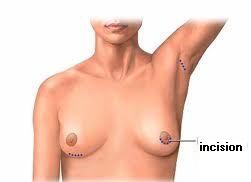BREAST AUGMENTATION (Breast Enlargement with Silicone Implant)

Breast, Aesthetic and Art
Breast augmentation is a surgical procedure to enhance the size and shape of a woman’s breast for a number of certain reasons. Breast augmentation enhances your appearance and your self-confidence.
By inserting silicone implants behind breasts, it is possible to increase a woman’s bustline by one or more bra cup sizes. Please find following detailed information regarding breast augmentation. It is not possible to answer all of your questions, since a lot depends on your individual circumstances. Please forward your questions if there is anything you don’t understand about the procedure.
The best candidates for breast augmentation are:
women who are looking for enhancement of appearance of their small and/or sagging breasts.
We use implant to do augmentation mammoplasty. A breast implant is a silicone shell filled with silicone gel. Within the last yeasrs, the technology of silicone implants improved dramatically and we have cohessive (memory gel).
Planning Your Surgery

Be sure to discuss your expectations frankly with your surgeon
In your initial consultation, your surgeon will evaluate your health and explain which surgical techniques are most appropriate for you, based on the condition of your breasts and skin tone. If your breasts are sagging, your doctor may also recommend a breast lift.
Be sure to discuss your expectations frankly with your surgeon. He or she should be equally frank with you, describing your alternatives and the risks and limitations of each. You may want to ask your surgeon for a copy of the manufacturer’s pamphlet that comes with the implant he or she will use — just so you are fully informed about it. And, be sure to tell your surgeon if you smoke, and if you’re taking any medications, vitamins, or other drugs.
Your surgeon should also explain the type of anesthesia to be used, the type of facility where the surgery will be performed, and the costs involved. Because most insurance companies do not consider breast augmentation to be medically necessary, carriers generally do not cover the cost of this procedure.
Where Your Surgery Will Be Performed
Your surgeon mostly prefer to perform the operation as an inpatient in a hospital, in which case you can plan on staying for a day or two.
Types of Anesthesia
Breast augmentation can be performed with a general anesthesia, so you’ll sleep through the entire operation.
The Surgery
 The method of inserting and positioning your implant will depend on your anatomy and your surgeon’s recommendation. The incision can be made:
The method of inserting and positioning your implant will depend on your anatomy and your surgeon’s recommendation. The incision can be made:
-either in the crease where the breast meets the chest,
-around the areola (the dark skin surrounding the nipple), or
-in the armpit.
Every effort will be made to assure that the incision is placed so resulting scars will be as inconspicuous as possible.
Working through the incision, the surgeon will lift your breast tissue and skin to create a pocket, either directly behind the breast tissue or underneath your chest wall muscle (the pectoral muscle). The implants are then centered beneath your nipples.
Some surgeons believe that putting the implants behind your chest muscle may reduce the potential for capsular contracture. Drainage tubes may be used for several days following the surgery. This placement may also interfere less with breast examination by mammogram than if the implant is placed directly behind the breast tissue. Placement behind the muscle however, may be more painful for a few days after surgery than placement directly under the breast tissue.

Type of Implant
 There are basically two kinds of implant:
There are basically two kinds of implant:
-Round
-Tear drop shaped (Anatomic)
Your surgeon will discuss you the reason which one he wants to use for what reasons. Please discuss your expectations with your surgeon at that stage.
You’ll want to discuss the pros and cons of these alternatives with your doctor before surgery to make sure you fully understand the implications of the procedure he or she recommends for you.
The surgery usually takes one hour to complete. Stitches are used to close the incisions, which may also be taped for greater support. A gauze bandage may be applied over your breasts to help with healing.
After Your Surgery
You’re likely to feel tired and sore for a few days following your surgery, but you’ll be up and around in 24 to 48 hours. Most of your discomfort can be controlled by medication prescribed by your doctor.
Within several days, the gauze dressings, if you have them, will be removed, and you may be given a surgical bra. You should wear it as directed by your surgeon. You may also experience a burning sensation in your nipples for about two weeks, but this will subside as bruising fades.
Your stitches will come out in a week to 10 days, but the swelling in your breasts may take three to five weeks to disappear.
Getting Back to Normal
You should be able to return to work within a few days, depending on the level of activity required for your job.
Follow your surgeon’s advice on when to begin exercises and normal activities. Your breasts will probably be sensitive to direct stimulation for two to three weeks, so you should avoid much physical contact. After that, breast contact is fine once your breasts are no longer sore, usually three to four weeks after surgery.
Your scars will be firm and pink for at least six weeks. Then they may remain the same size for several months, or even appear to widen. After several months, your scars will begin to fade, although they will never disappear completely.
Routine mammograms should be continued after breast augmentation for women who are in the appropriate age group, although the mammographic technician should use a special technique to assure that you get a reliable reading, as discussed earlier.
Your New Look
For many women, the result of breast augmentation can be satisfying, even exhilarating, as they learn to appreciate their fuller appearance.

Regular examination by your plastic surgeon and routine mammograms for those in the appropriate age groups at prescribed intervals will help assure that any complications, if they occur, can be detected early and treated.
Your decision to have breast augmentation is a highly personal one that not everyone will understand. The important thing is how you feel about it. If you’ve met your goals, then your surgery is a success.









